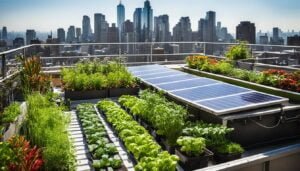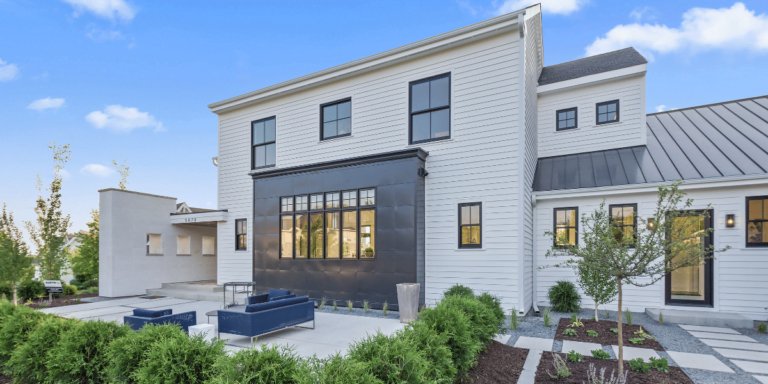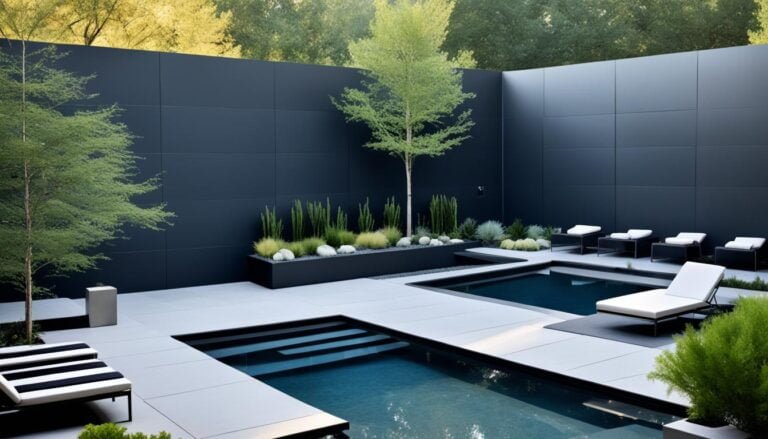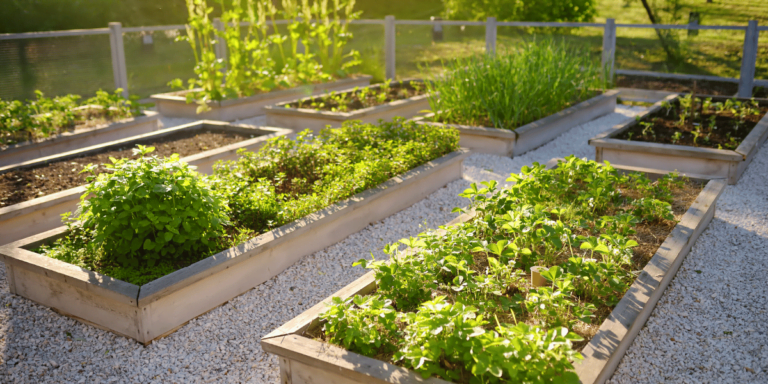Welcome to our practical guide on designing sustainable roof gardens. In this article, we will explore the key principles of eco-friendly landscape design and innovative water conservation techniques that can help you create a flourishing rooftop oasis. As urban environments continue to expand, it is crucial to integrate sustainability into our living spaces. By designing sustainable roof gardens, we can contribute to a greener and more environmentally friendly future.
Key Takeaways:
- Sustainable roof gardens promote eco-friendly landscape design and water conservation.
- By incorporating nature into urban areas, we can create a more sustainable and environmentally friendly environment.
- Design principles such as green roof ecosystems and biophilic design enhance the sustainability and aesthetic appeal of roof gardens.
- Smart garden automation and eco-friendly maintenance practices ensure the long-term health and vitality of roof gardens.
- Vertical gardening and hydroponic systems maximize space and minimize resource usage in roof gardens.
The Benefits of Sustainable Roof Gardens
Sustainable roof gardens offer a multitude of benefits that go beyond their aesthetic appeal. These eco-friendly spaces provide valuable solutions for promoting biodiversity, implementing high-tech smart gardening techniques, and embracing urban permaculture practices. By creating a harmonious balance between nature and urban living, sustainable roof gardens contribute to the conservation of natural resources and the preservation of wildlife habitats.
Wildlife Habitat Garden Creation
Sustainable roof gardens play a vital role in creating wildlife habitats within urban environments. These green oases provide sanctuary for birds, bees, butterflies, and other pollinators that are crucial for maintaining thriving ecosystems. By incorporating native plants and diverse vegetation, roof gardens attract a wide range of wildlife, allowing them to flourish amidst concrete jungles. This promotes biodiversity and helps restore the natural balance of urban landscapes.
High-Tech Smart Gardening
The integration of high-tech smart gardening techniques in sustainable roof gardens enhances their efficiency and sustainability. Through the use of innovative technologies such as smart irrigation systems, sensors, and automated monitoring, gardeners can optimize water usage and minimize wastage. This not only conserves precious resources but also reduces the overall environmental impact of these gardens. Additionally, smart gardening techniques facilitate remote monitoring and maintenance, making it easier for urban dwellers to engage in gardening activities and nurture their green spaces.
Urban Permaculture Practices
Sustainable roof gardens embrace urban permaculture practices, which focus on creating self-sustaining and regenerative systems within urban settings. By applying permaculture principles such as composting, rainwater harvesting, and natural pest control, these gardens become more resilient and self-sufficient. Urban permaculture practices also encourage community involvement and collaboration, fostering a sense of shared responsibility for creating sustainable urban environments.
Sustainable roof gardens offer a sanctuary for wildlife, contribute to the advancement of high-tech smart gardening, and promote urban permaculture practices. These benefits make them an invaluable addition to urban landscapes, nurturing both the environment and the well-being of urban dwellers. In the next section, we will explore the design principles that can help create sustainable roof gardens that are both aesthetically pleasing and ecologically responsible.
Design Principles for Sustainable Roof Gardens
When it comes to designing sustainable roof gardens, there are three essential principles to consider: green roof ecosystems, contemporary garden artistry, and biophilic design. By incorporating these elements, you can create a truly eco-friendly and visually stunning space that connects people with nature.
Green Roof Ecosystems
Green roof ecosystems play a crucial role in sustainable roof garden design. These systems involve the use of vegetation to cover the roof, providing a multitude of environmental benefits. The vegetation helps to absorb rainwater, reduce stormwater runoff, filter pollutants, and regulate the temperature of the building. Additionally, green roofs create habitat for birds, insects, and other wildlife, enhancing biodiversity in urban areas.
Contemporary Garden Artistry
Contemporary garden artistry brings a unique and creative touch to sustainable roof gardens. It involves the use of innovative techniques and materials to design visually appealing and functional outdoor spaces. From sleek and modern furniture to artistic plant arrangements, contemporary garden artistry adds a touch of elegance and sophistication to the rooftop oasis. By incorporating art and design into the garden, you create a harmonious blend of aesthetics and sustainability.
Biophilic Design Principles
Biophilic design principles focus on creating spaces that foster a deep connection with nature. This approach recognizes the innate human desire to be surrounded by natural elements and incorporates them into the design process. In sustainable roof gardens, biophilic design principles can be applied by including elements such as natural lighting, water features, and organic textures. These elements not only enhance the visual appeal of the garden but also promote emotional well-being and a sense of tranquility.
Incorporating green roof ecosystems, contemporary garden artistry, and biophilic design principles into your roof garden design will create a space that is both sustainable and aesthetically pleasing. By prioritizing environmental consciousness and connection with nature, you can design a rooftop oasis that enhances the urban landscape and promotes a healthier and more vibrant city environment.
Implementing Sustainable Solutions for Roof Garden Maintenance

When it comes to maintaining a sustainable roof garden, implementing smart garden automation systems and utilizing eco-friendly garden renovation techniques are essential. These solutions not only ensure efficient maintenance practices but also reduce the ecological footprint of the garden while promoting its long-term health and vitality.
Eco-Friendly Garden Renovation Techniques
Implementing eco-friendly garden renovation techniques is crucial for maintaining a sustainable roof garden. These techniques focus on minimizing waste, conserving resources, and promoting the health of the environment. Some effective eco-friendly garden renovation techniques to consider include:
- Using organic and locally sourced materials for garden improvements
- Implementing water-saving irrigation systems
- Practicing efficient waste management and recycling
- Selecting native and low-maintenance plant species
- Employing integrated pest management techniques to reduce the need for harmful chemicals
Smart Garden Automation Systems
Smart garden automation systems can significantly enhance the maintenance of a roof garden by streamlining various tasks and minimizing resource usage. These systems utilize innovative technologies to automate irrigation, lighting, and monitoring processes. Benefits of incorporating smart garden automation systems include:
- Optimized water usage through precise irrigation scheduling and intelligent moisture sensors
- Energy-efficient LED lighting systems for enhanced plant growth and visual appeal
- Remote monitoring and control of garden parameters through smart devices
- Integration with weather forecasts to ensure efficient watering and protect against extreme weather conditions
- Automatic adjustment of irrigation and lighting settings based on plant needs and environmental factors
By implementing these sustainable solutions for roof garden maintenance, you can create a low-maintenance and eco-friendly oasis that thrives with minimal human intervention. These practices contribute to a greener and more sustainable future, while also providing a beautiful and serene space for relaxation and enjoyment.
Maximizing Space with Vertical and Hydroponic Systems

When it comes to designing space-efficient roof gardens, incorporating vertical gardening techniques and indoor hydroponic systems can be a game-changer. These innovative methods allow for the cultivation of a wide variety of plants in limited space while conserving resources such as soil and water.
Space-efficient Vertical Gardening
Vertical gardening is a space-saving technique that utilizes vertical surfaces to grow plants. By utilizing walls, fences, or specially designed structures, you can expand your gardening capabilities without taking up valuable floor space. This technique is particularly beneficial for small rooftop gardens where space is limited.
Vertical gardens can be created using various methods, including:
- Vertical planters: These are specially designed pots or containers that can be stacked vertically, allowing you to grow multiple plants in a compact area.
- Trellises and arbors: These structures provide support for climbing plants, such as vines or tomatoes, enabling them to grow vertically and create a lush green wall.
- Living walls: Living walls are vertical installations that consist of plants embedded in a specially designed system. They can be customized to suit the available space and aesthetic preferences, creating a stunning visual focal point.
By implementing space-efficient vertical gardening techniques, you can maximize the greenery in your roof garden while adding a touch of aesthetic charm. The vertical orientation not only saves space but also enhances air circulation and promotes efficient water drainage, ensuring the health and longevity of your plants.
Indoor Hydroponic Systems
Another space-efficient solution for roof gardens is the use of indoor hydroponic systems. Hydroponics is a soilless cultivation method that utilizes water-based nutrient solutions to grow plants. By adopting this system indoors, you can cultivate plants without the need for soil, resulting in a more efficient use of space.
There are different types of hydroponic systems available, including:
- Nutrient Film Technique (NFT): This system uses a continuous flow of nutrient-rich water that flows over the roots of the plants, providing them with a constant supply of nutrients.
- Deep Water Culture (DWC): In this system, the plants’ roots are suspended in a nutrient-rich solution, with an air pump providing oxygen to the roots.
- Drip System: This system involves a drip emitter that delivers a measured amount of nutrient solution to each plant, ensuring precise nutrient delivery.
Indoor hydroponic systems offer several advantages for rooftop gardens. They allow for the cultivation of a wide variety of plants, including herbs, vegetables, and even fruits, in a smaller space. The controlled environment provided by these systems enables optimal growth conditions, resulting in faster plant growth and higher yields compared to traditional soil-based gardening.
| Benefits of Space-efficient Vertical Gardening | Benefits of Indoor Hydroponic Systems |
|---|---|
|
|
By combining space-efficient vertical gardening techniques with indoor hydroponic systems, you can optimize the utilization of space in your roof garden while enjoying a wide range of plant varieties. These methods not only offer practical solutions for limited space but also contribute to sustainable and environmentally friendly gardening practices.
Conclusion
Designing sustainable roof gardens requires careful consideration of various factors to create an environmentally friendly and visually appealing space. One of the key aspects to prioritize is implementing organic composting methods. By utilizing compost made from organic waste, you can enrich the soil, provide essential nutrients to the plants, and reduce waste sent to landfills.
Another important element to incorporate is renewable energy in eco-gardens. By harnessing solar or wind power, you can minimize the environmental impact of your roof garden while also reducing energy costs. Investing in renewable energy sources not only benefits the environment but also creates a more self-sufficient and sustainable garden.
Additionally, creating green roof ecosystems is essential in sustainable roof garden design. Green roofs help regulate temperature, provide insulation, and improve air quality. By incorporating green roof ecosystems, you are not only enhancing the aesthetic appeal of your garden but also contributing to biodiversity and creating habitats for birds, insects, and other wildlife.
By following these guidelines and incorporating organic composting methods, utilizing renewable energy sources, and creating green roof ecosystems, you can design a beautiful and environmentally friendly roof garden. Embracing sustainability not only enhances the urban landscape but also plays a vital role in promoting a greener and more sustainable future.
FAQ
What is a designing sustainable roof garden?
A sustainable roof garden is a garden designed on rooftops that incorporates eco-friendly landscape design principles and utilizes innovative water conservation techniques, contributing to a sustainable and environmentally friendly urban environment.
What are the benefits of sustainable roof gardens?
Sustainable roof gardens provide a multitude of benefits, including creating habitat for wildlife, utilizing high-tech smart gardening techniques, and implementing urban permaculture practices. These gardens promote the conservation of natural resources and the preservation of biodiversity.
What design principles should be considered for sustainable roof gardens?
To ensure sustainability and aesthetic appeal, it is important to adhere to green roof ecosystem principles, incorporate contemporary garden artistry techniques, and follow biophilic design principles when designing roof gardens.
How can sustainable solutions be implemented for roof garden maintenance?
Smart garden automation systems and eco-friendly garden renovation techniques can be utilized for efficient and environmentally conscious maintenance practices. These solutions reduce the ecological footprint of the garden and promote its long-term health and vitality.
How can space be maximized in roof gardens?
Space-efficient vertical gardening techniques and indoor hydroponic systems can be incorporated to maximize space in roof gardens. These methods allow for the cultivation of a wide variety of plants while minimizing soil usage and water consumption.










